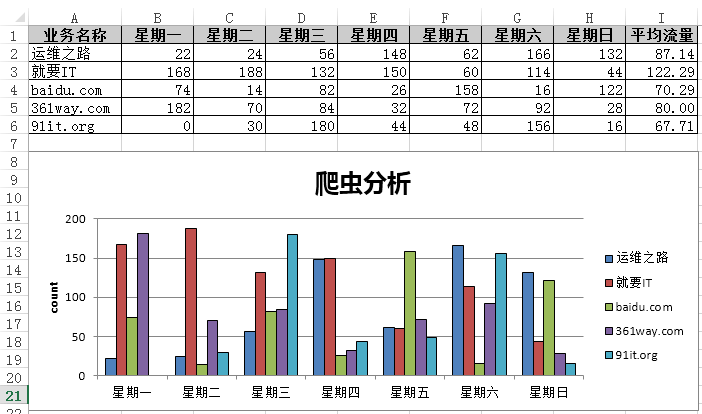本篇讲下如何使用纯python代码将excel 中的图表导出为图片。这里需要使用的模块有win32com、pythoncom模块。
网上经查询有人已经写好的模块pyxlchart,具体代码如下:
|
1
2
3
4
5
6
7
8
9
10
11
12
13
14
15
16
17
18
19
20
21
22
23
24
25
26
27
28
29
30
31
32
33
34
35
36
37
38
39
40
41
42
43
44
45
46
47
48
49
50
51
52
53
54
55
56
57
58
59
60
61
62
63
64
65
66
67
68
69
70
71
72
73
74
75
76
77
78
79
80
81
82
83
84
85
86
87
88
89
90
91
92
93
94
|
from win32com.client import Dispatchimport osimport pythoncomclass Pyxlchart(object): """ This class exports charts in an Excel Spreadsheet to the FileSystem win32com libraries are required. """ def __init__(self): pythoncom.CoInitialize() self.WorkbookDirectory = '' self.WorkbookFilename = '' self.GetAllWorkbooks = False self.SheetName = '' self.ChartName = '' self.GetAllWorkbookCharts = False self.GetAllWorksheetCharts = False self.ExportPath = '' self.ImageFilename = '' self.ReplaceWhiteSpaceChar = '_' self.ImageType = 'jpg' def __del__(self): pass def start_export(self): if self.WorkbookDirectory == '': return "WorkbookDirectory not set" else: self._export() def _export(self): """ Exports Charts as determined by the settings in class variabels. """ excel = Dispatch("excel.application") excel.Visible = False wb = excel.Workbooks.Open(os.path.join(self.WorkbookDirectory ,self.WorkbookFilename)) self._get_Charts_In_Worksheet(wb,self.SheetName,self.ChartName) wb.Close(False) excel.Quit() def _get_Charts_In_Worksheet(self,wb,worksheet = "", chartname = ""): if worksheet != "" and chartname != "": sht = self._change_sheet(wb,worksheet) cht = sht.ChartObjects(chartname) self._save_chart(cht) return if worksheet == "": for sht in wb.Worksheets: for cht in sht.ChartObjects(): if chartname == "": self._save_chart(cht) else: if chartname == cht.Name: self._save_chart(cht) else: sht = wb.Worksheets(worksheet) for cht in sht.ChartObjects(): if chartname == "": self._save_chart(cht) else: if chartname == cht.Name: self._save_chart(cht) def _change_sheet(self,wb,worksheet): try: return wb.Worksheets(worksheet) except: raise NameError('Unable to Select Sheet: ' + worksheet + ' in Workbook: ' + wb.Name) def _save_chart(self,chartObject): imagename = self._get_filename(chartObject.Name) savepath = os.path.join(self.ExportPath,imagename) print savepath chartObject.Chart.Export(savepath,self.ImageType) def _get_filename(self,chartname): """ Replaces white space in self.WorkbookFileName with the value given in self.ReplaceWhiteSpaceChar If self.ReplaceWhiteSpaceChar is an empty string then self.WorkBookFileName is left as is """ if self.ImageFilename == '': self.ImageFilename == chartname if self.ReplaceWhiteSpaceChar != '': chartname.replace(' ',self.ReplaceWhiteSpaceChar) if self.ImageFilename != "": return self.ImageFilename + "_" + chartname + "." + self.ImageType else: return chartname + '.' + self.ImageTypeif __name__ == "__main__": xl = Pyxlchart() xl.WorkbookDirectory = "\\\\maawtns01\\discipline\\procurement\\MATERIEL\\Raw Material\\Data Management\\Hawk" xl.WorkbookFilename = "Hawk Workability KPI.xlsm" xl.SheetName = "" xl.ImageFilename = "MyChart1" xl.ExportPath = "d:\\pycharts" xl.ChartName = "" xl.start_export() print "This file does not currently allow direct access" print "Please import PyXLChart and run start_export()" |
这里还使用Excel vba将chart另存为图片篇中创建的chart_column.xlsx表,使用上面的模块的方法如下:
|
1
2
3
4
5
6
7
8
9
|
from pyxlchart import Pyxlchartxl = Pyxlchart()xl.WorkbookDirectory = "D:\\"xl.WorkbookFilename = "chart_column.xlsx"xl.SheetName = ""#xl.ImageFilename = "MyChart1"xl.ExportPath = "d:\\"xl.ChartName = ""xl.start_export() |
由于有该表里有多张图表,所以上面未指定xl.ImageFilename ,使用示例如下:

Excel vba将chart另存为图片
python下使用xlswriter模块,可以轻松在excel 中创建图片,不过想实现将生成的chart图表导出为图片,在email 中导入图片的目标 。经网上查询未找到通过python代码将excel 中已经生成的图片导出为图片的方法,不过通过变通方法,使用excel 内的vba 宏却可以轻松将图片导出。
1、导出单张图片
python 创建chart图片代码:
|
1
2
3
4
5
6
7
8
9
10
11
12
13
14
15
16
17
18
19
20
21
22
23
24
25
26
27
28
29
30
31
32
33
34
35
36
37
38
39
40
41
42
43
44
45
46
47
48
49
50
51
52
53
54
55
56
|
#coding: utf-8import xlsxwriterimport randomdef get_num(): return random.randrange(0, 201, 2)workbook = xlsxwriter.Workbook('analyse_spider.xlsx') #创建一个Excel文件worksheet = workbook.add_worksheet() #创建一个工作表对象chart = workbook.add_chart({'type': 'column'}) #创建一个图表对象#定义数据表头列表title = [u'业务名称',u'星期一',u'星期二',u'星期三',u'星期四',u'星期五',u'星期六',u'星期日',u'平均流量']buname= [u'运维之路',u'就要IT',u'baidu.com',u'361way.com',u'91it.org'] #定义频道名称#定义5频道一周7天流量数据列表data = []for i in range(5): tmp = [] for j in range(7): tmp.append(get_num()) data.append(tmp)format=workbook.add_format() #定义format格式对象format.set_border(1) #定义format对象单元格边框加粗(1像素)的格式format_title=workbook.add_format() #定义format_title格式对象format_title.set_border(1) #定义format_title对象单元格边框加粗(1像素)的格式format_title.set_bg_color('#cccccc') #定义format_title对象单元格背景颜色为 #'#cccccc'的格式format_title.set_align('center') #定义format_title对象单元格居中对齐的格式format_title.set_bold() #定义format_title对象单元格内容加粗的格式format_ave=workbook.add_format() #定义format_ave格式对象format_ave.set_border(1) #定义format_ave对象单元格边框加粗(1像素)的格式format_ave.set_num_format('0.00') #定义format_ave对象单元格数字类别显示格式#下面分别以行或列写入方式将标题、业务名称、流量数据写入起初单元格,同时引用不同格式对象worksheet.write_row('A1',title,format_title)worksheet.write_column('A2', buname,format)worksheet.write_row('B2', data[0],format)worksheet.write_row('B3', data[1],format)worksheet.write_row('B4', data[2],format)worksheet.write_row('B5', data[3],format)worksheet.write_row('B6', data[4],format)#定义图表数据系列函数def chart_series(cur_row): worksheet.write_formula('I'+cur_row, \ '=AVERAGE(B'+cur_row+':H'+cur_row+')',format_ave) #计算(AVERAGE函数)频 #道周平均流量 chart.add_series({ 'categories': '=Sheet1!$B$1:$H$1', #将“星期一至星期日”作为图表数据标签(X轴) 'values': '=Sheet1!$B$'+cur_row+':$H$'+cur_row, #频道一周所有数据作 #为数据区域 'line': {'color': 'black'}, #线条颜色定义为black(黑色) 'name': '=Sheet1!$A$'+cur_row, #引用业务名称为图例项 })for row in range(2, 7): #数据域以第2~6行进行图表数据系列函数调用 chart_series(str(row))chart.set_size({'width': 577, 'height': 287}) #设置图表大小chart.set_title ({'name': u'爬虫分析'}) #设置图表(上方)大标题chart.set_y_axis({'name': 'count'}) #设置y轴(左侧)小标题worksheet.insert_chart('A8', chart) #在A8单元格插入图表workbook.close() #关闭Excel文档 |

由于这里只有一张图片,通过vba 代码很容易生成图片 。方法为,打开该excel 图表,通过alt + F11 快捷键打开宏编辑界面;打开VB编辑器的立即窗口:”视图“-”立即窗口“,或者使用快捷键"Ctrl + G" ,接着输入如下代码
|
1
|
activesheet.ChartObjects(1).Chart.Export "C:\chart.png" |
按 " Enter " 键后,会在C盘生成上面的生成的chart图表。
二、导出多张图表
python代码如下:
|
1
2
3
4
5
6
7
8
9
10
11
12
13
14
15
16
17
18
19
20
21
22
23
24
25
26
27
28
29
30
31
32
33
34
35
36
37
38
39
40
41
42
43
44
45
46
47
48
49
50
51
52
53
54
55
56
57
58
59
60
61
62
63
64
65
66
67
68
69
70
71
72
73
74
75
76
77
78
79
80
81
82
83
84
85
86
87
88
89
90
|
#coding: utf-8import xlsxwriterworkbook = xlsxwriter.Workbook('chart_column.xlsx')worksheet = workbook.add_worksheet()bold = workbook.add_format({'bold': 1})# 这是个数据table的列headings = ['Number', 'Batch 1', 'Batch 2']data = [ [2, 3, 4, 5, 6, 7], [10, 40, 50, 20, 10, 50], [30, 60, 70, 50, 40, 30],]worksheet.write_row('A1', headings, bold)worksheet.write_column('A2', data[0])worksheet.write_column('B2', data[1])worksheet.write_column('C2', data[2])#############################################创建一个图表,类型是columnchart1 = workbook.add_chart({'type': 'column'})# 配置series,这个和前面wordsheet是有关系的。chart1.add_series({ 'name': '=Sheet1!$B$1', 'categories': '=Sheet1!$A$2:$A$7', 'values': '=Sheet1!$B$2:$B$7',})# Configure a second series. Note use of alternative syntax to define ranges.chart1.add_series({ 'name': ['Sheet1', 0, 2], 'categories': ['Sheet1', 1, 0, 6, 0], 'values': ['Sheet1', 1, 2, 6, 2],})# Add a chart title and some axis labels.chart1.set_title ({'name': 'Results of sample analysis'})chart1.set_x_axis({'name': 'Test number'})chart1.set_y_axis({'name': 'Sample length (mm)'})# Set an Excel chart style.chart1.set_style(11)# Insert the chart into the worksheet (with an offset).worksheet.insert_chart('D2', chart1, {'x_offset': 25, 'y_offset': 10})######################################################################### Create a stacked chart sub-type.#chart2 = workbook.add_chart({'type': 'column', 'subtype': 'stacked'})# Configure the first series.chart2.add_series({ 'name': '=Sheet1!$B$1', 'categories': '=Sheet1!$A$2:$A$7', 'values': '=Sheet1!$B$2:$B$7',})# Configure second series.chart2.add_series({ 'name': '=Sheet1!$C$1', 'categories': '=Sheet1!$A$2:$A$7', 'values': '=Sheet1!$C$2:$C$7',})# Add a chart title and some axis labels.chart2.set_title ({'name': 'Stacked Chart'})chart2.set_x_axis({'name': 'Test number'})chart2.set_y_axis({'name': 'Sample length (mm)'})# Set an Excel chart style.chart2.set_style(12)# Insert the chart into the worksheet (with an offset).worksheet.insert_chart('D18', chart2, {'x_offset': 25, 'y_offset': 10})######################################################################### Create a percentage stacked chart sub-type.#chart3 = workbook.add_chart({'type': 'column', 'subtype': 'percent_stacked'})# Configure the first series.chart3.add_series({ 'name': '=Sheet1!$B$1', 'categories': '=Sheet1!$A$2:$A$7', 'values': '=Sheet1!$B$2:$B$7',})# Configure second series.chart3.add_series({ 'name': '=Sheet1!$C$1', 'categories': '=Sheet1!$A$2:$A$7', 'values': '=Sheet1!$C$2:$C$7',})# Add a chart title and some axis labels.chart3.set_title ({'name': 'Percent Stacked Chart'})chart3.set_x_axis({'name': 'Test number'})chart3.set_y_axis({'name': 'Sample length (mm)'})# Set an Excel chart style.chart3.set_style(13)# Insert the chart into the worksheet (with an offset).worksheet.insert_chart('D34', chart3, {'x_offset': 25, 'y_offset': 10})workbook.close() |
同一数据源上面创建了三种类型的图 ,由于有三张图,上面的导出一张图的方法肯定是不行了,这里打开宏,创建如下宏内容:
|
1
2
3
4
5
6
|
Sub exportimg()Dim XlsChart As ChartObjectFor Each XlsChart In Worksheets("Sheet1").ChartObjects XlsChart.Chart.Export Filename:="C:\" & XlsChart.Name & ".jpg", FilterName:="JPG"NextEnd Sub |
该示例这里就不再截图,具体可以自行运行。










